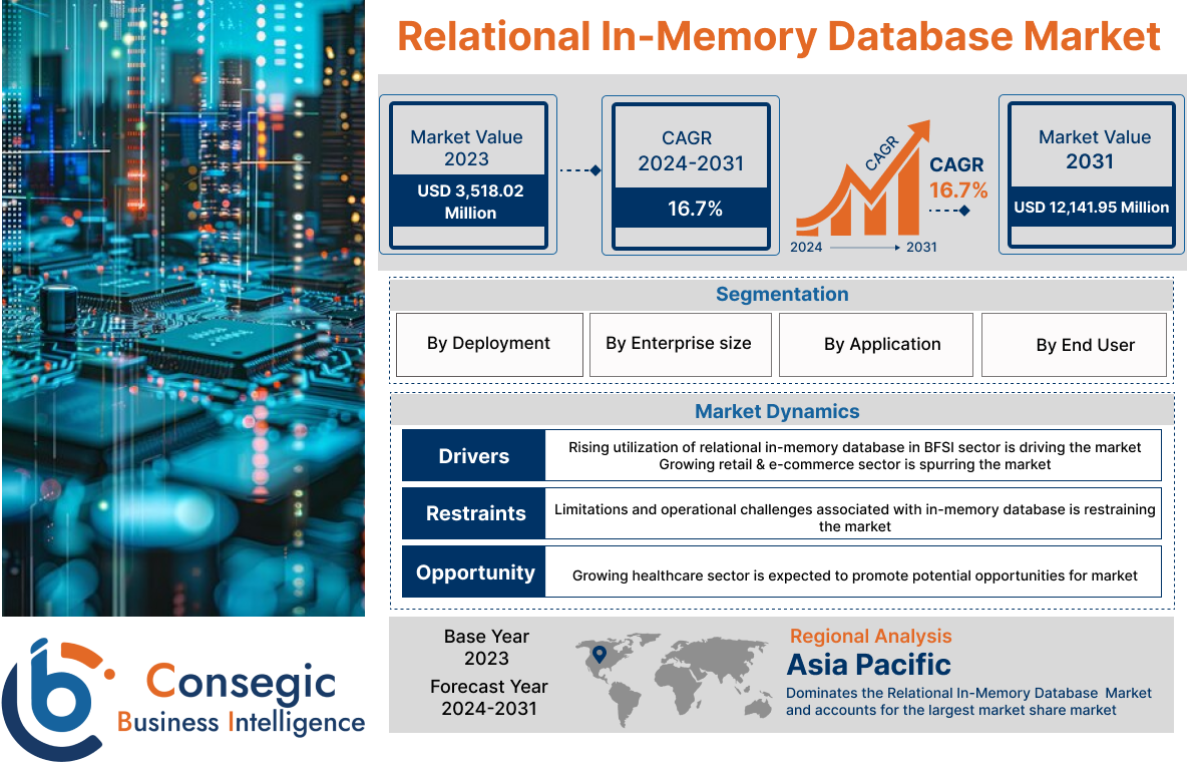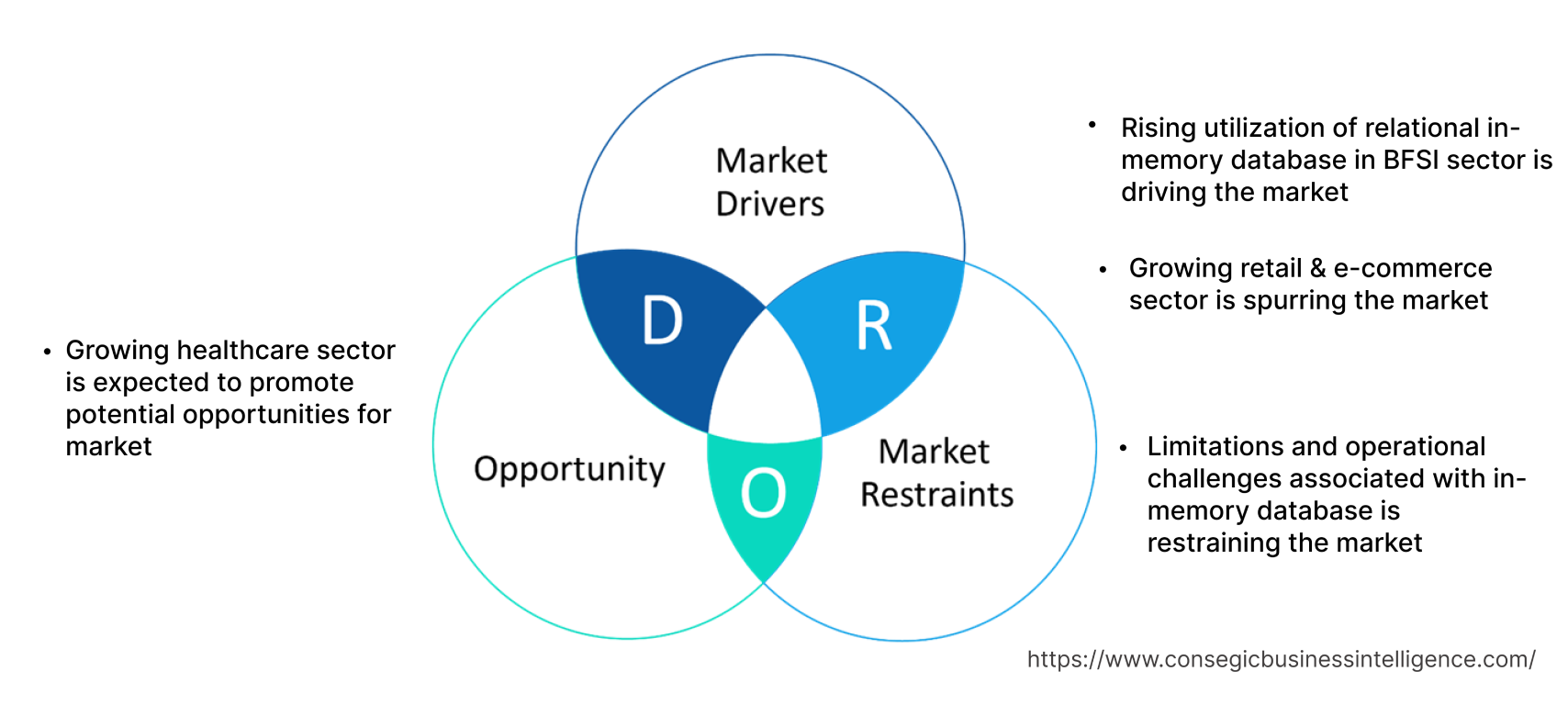- Summary
- Table Of Content
- Methodology
Relational In-Memory Database Market Size :
Relational In-Memory Database Market size is estimated to reach over USD 12,141.95 Million by 2031 from a value of USD 3,518.02 Million in 2023, growing at a CAGR of 16.7% from 2024 to 2031.
Relational In-Memory Database Market Scope & Overview :
Relational in-memory database refers to a purpose-built database that primarily depends on internal memory for data storage. The in-memory database facilitates minimal response times by eliminating the need to access standard disk drives. Moreover, as per the analysis, the in-memory database offers a range of benefits including low latency, high throughput, real-time responses, high scalability, and others. The aforementioned benefits of l in-memory databases are key determinants for increasing its utilization in BFSI, healthcare, retail & e-commerce, manufacturing, and other industries.
Relational In-Memory Database Market Insights :
Key Drivers :
Rising utilization of relational in-memory database in BFSI sector is driving the market
Relational in-memory database is primarily used in BFSI (Banking, Financial Services and Insurance) sector for real-time analytics for improving business health and discovering insights for informed decision-making. Moreover, the in-memory database is also used by banking and financial institutions for monitoring credit transactions and predicting or detecting fraudulent transactions. As per the analysis, the benefits of the in-memory database including exceptionally fast response time and high throughput make it ideal for use in transaction processing applications and real-time analytics for banking/financial purposes such as fraud detection, risk mitigation, and portfolio management among others.
Factors including rising digitalization of BFSI sector, prevalence of substantial number of banking/financial institutions, and rising need for efficient fraud detection and monitoring solutions in BFSI firms are among the key prospects driving the market demand.
For instance, according to the European Union, there are approximately 5,441 banks operating in EU region, among which Germany accounted for 28% of the total number of banks in EU, followed by Poland with 11%, Austria and Italy with 9% each, and the rest in other EU member states.
Additionally, according to Federal Deposit Insurance Corporation (FDIC), United States comprised of approximately 4,136 commercial banks along with 69,905 total branches across the country as of 2022. Thus, the prevalence of significant number of banking firms is increasing the adoption of the in-memory database for fraud detection and monitoring application, in turn proliferating the demand of the market.
Growing retail & e-commerce sector is spurring the market
Relational in-memory database is primarily used in retail & e-commerce sector for facilitating supply chain management while driving operational efficiency and higher sales volume. Based on the analysis, the in-memory database provides retailers with the capability to run advanced, detailed simulations for identifying potential bottlenecks along the supply chain and adjusting real-world practices accordingly. Moreover, retail & e-commerce companies can also use the in-memory database for real-time streaming analytics to track inventory, improve operations, gather trend insights, and boost sales volumes.
Factors including the rise in digitalization, increasing consumer preference for online shopping, and growing need for retail warehousing and management solutions by retail enterprises are among the primary aspects driving the adoption of the in-memory database.
For instance, in April 2022, the government of India announced its plan to launch an online retail network across 100 Indian cities to provide consumers with an alternative to multinational platforms including Amazon and Flipkart. Additionally, according to the U.S. Census Bureau of the Department of Commerce, the retail e-commerce sector in the United States was valued at USD 265.95 billion during the third quarter of 2022, representing a significant rise of 10.8% in comparison to USD 239.97 billion during the third quarter of 2021.
Thus, the growing retail & e-commerce sector is further driving the adoption of the in-memory database for facilitating supply chain management and real-time streaming analytics for driving operational efficiency and higher sales volume. The above factors are driving the demand of the market.
Key Restraints :
Limitations and operational challenges associated with in-memory database is restraining the market
The implementation of this in-memory database is associated with few limitations and operational challenges, which is a key factor limiting the relational in-memory database market demand.
For instance, in-memory databases require a high total cost of ownership and are often associated with reliability issues and restart delays when memory limits are exceeded. Additionally, the primary limitation of in-memory database includes its volatility, wherein all data in the memory can be lost if the system crashes or loses power.
Further, as per the analysis, the in-memory database is associated with data storage constraints due to cost and hardware limitations. The volume of data that can be stored in memory is usually less in comparison to the amount of data that can be stored on disk. Therefore, the above limitations and operational challenges related to deployment of an in-memory database are restricting the expansion of the market.
Future Opportunities :
Growing healthcare sector is expected to promote potential opportunities for market
The growing healthcare sector is expected to present potential relational in-memory database market opportunities and trends for the expansion of the relational in-memory database market. The in-memory database is often used in healthcare sector for facilitating real-time analytics for improving organizational efficiency while providing enhanced patient experiences. The utilization of this in-memory database enables healthcare administrators to use real-time analytics for assessing clinical risk, monitoring patient safety, personalizing patient results, and reducing patient readmissions.
Factors including the increasing trend in healthcare expenditure, rising incidence of diagnostics and surgical procedures, and growing number of in-patient admissions are primary aspects driving the expansion of the healthcare industry.
For instance, according to American Medical Association, the total healthcare spending in the United States reached up to USD 4.3 trillion in 2021, witnessing a growth of 2.7% in comparison to 2020. Moreover, healthcare expenditure in the United States accounted for nearly 18.3% of the total GDP in 2021. Further, the European Commission invested approximately USD 6 billion budget during the 2021-27 period for supporting the healthcare sector in Europe.
Hence, the growing healthcare industry is anticipated to increase the utilization of this in-memory database for assessing clinical risk, monitoring patient safety, and personalizing patient results, in turn promoting opportunities and trends for market expansion during the forecast period.
Relational In-Memory Database Market Report Insights :
| Report Attributes | Report Details |
| Study Timeline | 2018-2031 |
| Market Size in 2031 | USD 12,141.95 Million |
| CAGR (2024-2031) | 16.7% |
| By Deployment | Cloud and On-Premise |
| By Enterprise Size | Large Enterprise and Small & Medium Enterprise |
| By Application | Analytics, Supply Chain Management, Fraud Detection, and Others |
| By End-User | BFSI, Healthcare, Retail & E-Commerce, Manufacturing, and Others |
| By Region | Asia-Pacific, Europe, North America, Latin America, Middle East & Africa |
| Key Players | Oracle, SAP, ENEA, Microsoft, IBM Corporation, Amazon Web Services Inc., Volt Active Data Inc., DataStax, McObject, Teradata |
| Geographies Covered | |
| North America | U.S. Canada Mexico |
| Europe | U.K. Germany France Spain Italy Russia Benelux Rest of Europe |
| APAC | China South Korea Japan India Australia ASEAN Rest of Asia-Pacific |
| Middle East and Africa | GCC Turkey South Africa Rest of MEA |
| LATAM | Brazil Argentina Chile Rest of LATAM |
| Report Coverage | Revenue Forecast, Competitive Landscape, Growth Factors, Restraint or Challenges, Opportunities, Environment & Regulatory Landscape, PESTLE Analysis, PORTER Analysis, Key Technology Landscape, Value Chain Analysis, Cost Analysis, and Regional Trends & Forecast |
Relational In-Memory Database Market Segmental Analysis :
By Deployment :
Based on the deployment, the market is bifurcated into cloud and on premise. The cloud segment accounted for a substantial revenue share in the year 2023. The cloud-based deployment offers a seamless collaboration along with fast and cost-effective access to the in-memory database by multiple users irrespective of the time and location of the user. Moreover, cloud-based relational in-memory databases offer various benefits such as minimal capital expense, rapid implementation, ease of utilization and integration, faster processing, and higher scalability. The above benefits of cloud-based deployment are prime factors for driving its utilization in the deployment of the in-memory databases.
For instance, SAP offers SAP HANA relational in-memory database that offers flexible deployment in public or private cloud. SAP HANA offers advanced analytics, search, and data integration capabilities for all types of structured and unstructured data. Thus, the increasing availability of the in-memory database for cloud-based deployment is a key factor proliferating the expansion of the segment.
As per the analysis, the on premise segment is anticipated to register significant CAGR expansion during the forecast period. On-premise deployment enables enterprises to manage, and have complete control over its integrations, and maintain tighter control over the application's security aspects as compared to cloud-based deployments. Moreover, the benefits of on premise deployment such as higher security, privacy, lower network bandwidth costs, and more control over server hardware are key factors determinants for increasing its utilization in the deployment of the in-memory databases.
For instance, Teradata is a provider of the in-memory database that offers on premise deployment of its database to deliver maximum security and high performance. Thus, the rising prevalence of this in-memory database providers offering on premise deployment options is a primary factor anticipated to drive the expansion of the market during the forecast period.
By Enterprise Size :
Based on the enterprise size, the market is segregated into large enterprise and small & medium enterprise. The large enterprise segment accounted for the largest revenue share in the year 2023. Large enterprises refer to companies that have an above-average business size, perform large operations, and have high economies of scale. Large enterprises primarily comprise of a larger workforce, generate a high amount of revenue, and have a greater competitive capacity in comparison to small and medium enterprises. Moreover, large enterprises operating in Relational In-Memory Database industry often target national and international markets for delivery of advanced design and manufacturing services.
For instance, Oracle, SAP, and Intel Corporation are few of the large enterprises that offer this in-memory database for BFSI, retail, healthcare, and other industrial sectors. Thus, the prevalence of large enterprises operating in the in-memory database sector is a key factor driving the expansion of the segment.
Small & medium enterprise segment is expected to witness fastest CAGR expansion during the forecast period. Small and medium enterprises refer to companies that maintain revenues, workforce, and assets below a certain threshold. SMEs often account for the majority of the businesses that are operating across the world. SMEs are segregated from large enterprises because it operates differently with more simple operations.
For instance, Volt Active Data Inc. is a U.S.-based medium size enterprise operating in the relational in-memory database sector. The company's in-memory database offers real-time data processing with high scalability, accuracy, and resiliency. Thus, the rising development of small & medium enterprises operating in the in-memory database sector is projected to boost the expansion of the segment during the forecast period.
By Application :
Based on the application, the market is classified into analytics, supply chain management, fraud detection, and others. The analytics segment accounted for the largest revenue share of 39.54% in the year 2023. The in-memory database is primarily used for application in real-time analytics for improving business health and discovering insights for informed decision-making among business organizations. Moreover, as per the analysis, the in-memory database stores data in internal memory to accelerate data analysis and provide users with real-time insights, without compromising on performance. Additionally, the in-memory database is primarily used for application in real-time analytics in multiple industries including BFSI, healthcare, retail, and others.
For instance, Oracle offers in-memory database in its portfolio that is integrated with a range of features for real-time analytics application with improved performance and scalability. Hence, the rising development of this in-memory database market trends for analytics application is a prime factor fostering the expansion of the market.
Fraud detection segment is expected to witness fastest CAGR growth during the forecast period. The in-memory database is often used for fraud detection application, particularly in the banking and financial sector. The in-memory database enables banking and financial institutions to monitor credit transactions and predict or detect fraudulent transactions.
For instance, Terdata offers in-memory database solution for fraud detection and prevention application for banking and financial institutions. The company's in-memory database is optimized for utilization by financial institutions to automate risk and fraud detection for increasing customer retention. Thus, the increasing utilization of this in-memory database for fraud detection application in BFSI institutions is anticipated to boost the market expansion during the forecast period.
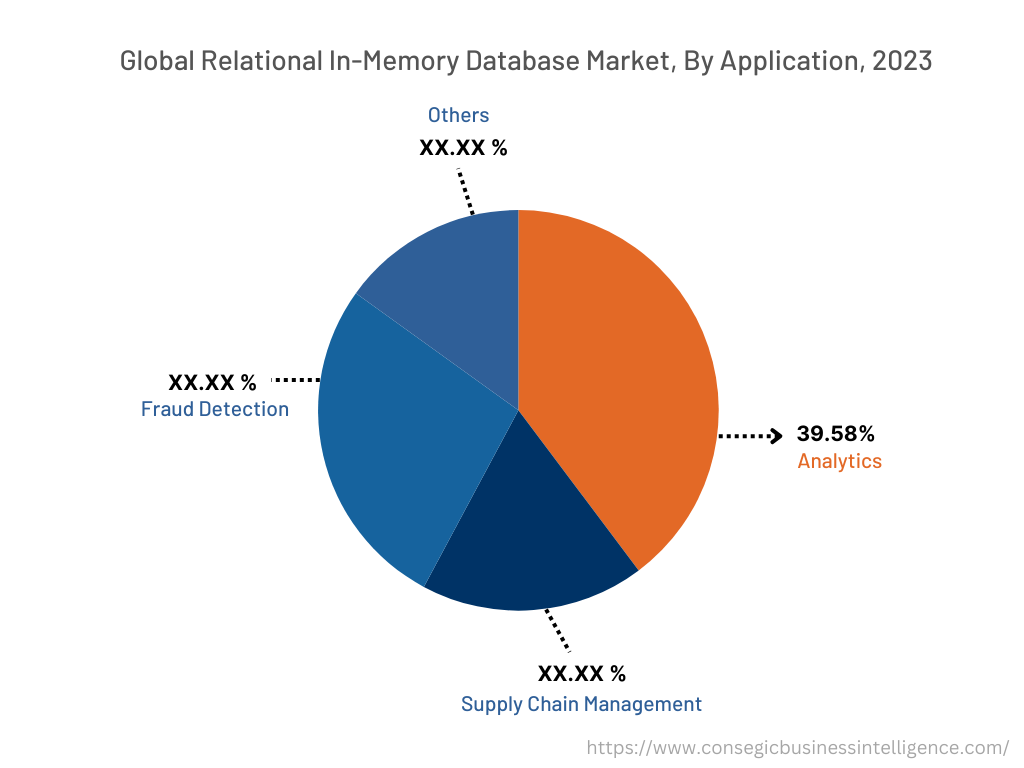
By End-User :
Based on the end-user, the market is segregated into BFSI, healthcare, retail & e-commerce, manufacturing, and others. The BFSI segment accounted for the largest revenue share in the year 2023. Factors including the rising digitalization of the BFSI sector, the prevalence of substantial number of banking/financial institutions, and rising need for efficient fraud detection and monitoring solutions in BFSI firms are crucial aspects driving the expansion of the BFSI segment.
For instance, according to the Canadian Bankers Association, the banking sector in Canada consisted of 5,711 bank branches in 2021. Therefore, the prevalence of significant number of banking firms is driving the market demand for The in-memory database for fraud detection and monitoring application, in turn proliferating the expansion of the market.
Retail & e-commerce segment is expected to witness fastest CAGR during the forecast period. The expansion of retail & e-commerce segment is primarily driven by multiple factors including expansion of retail enterprises, increasing consumer preference for online shopping, and growing need for retail warehousing and management solutions by retail enterprises among others.
For instance, according to Europe E-commerce Report 2022, the sales volume of online retail sector in Hungary was valued at approximately USD 3.7 billion in 2021, with online orders reaching up to 68.9 million in total. Thus, the growing retail & e-commerce sector is increasing the adoption of the in-memory database for facilitating supply chain management while driving operational efficiency and higher sales volume, in turn boosting the market growth during the forecast period.
By Region :
The regional segment includes North America, Europe, Asia Pacific, Middle East and Africa, and Latin America.
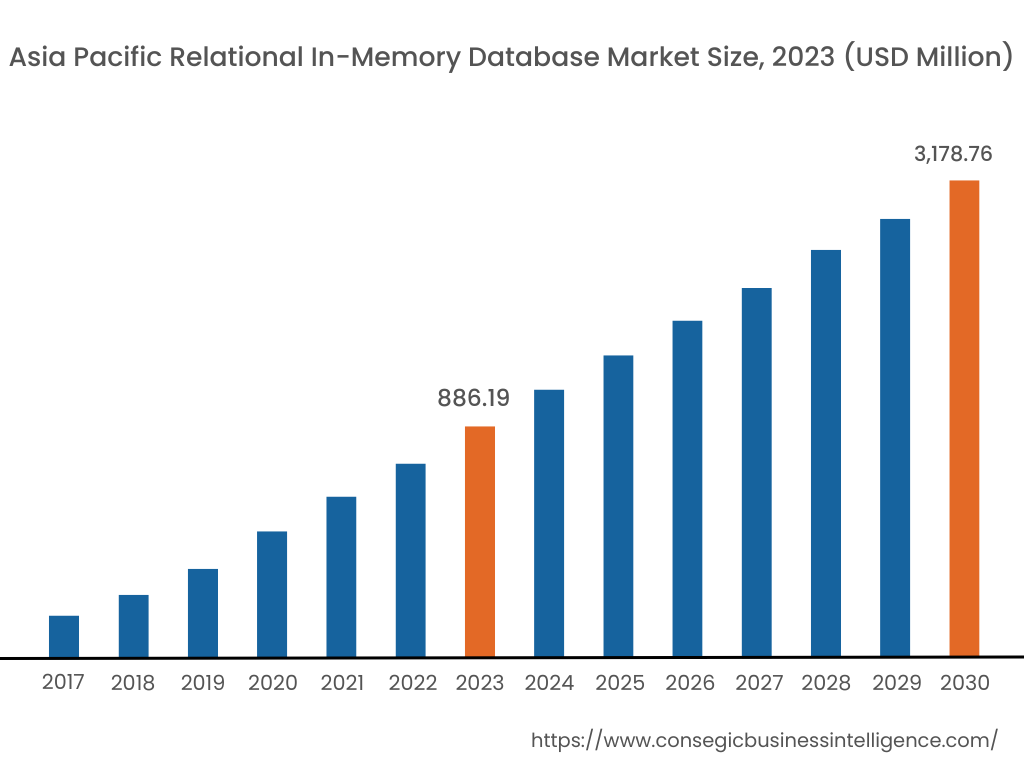
Asia Pacific accounted for the largest relational in-memory database market share of USD 886.19 Million in 2023 and is expected to reach USD 3,178.76 Million by 2031, registering the highest CAGR of 17.3% during the forecast period. In addition, in the region, the China accounted for the maximum revenue share of 31.5% in the same year.
As per the relational in-memory database market analysis, the growing pace of industrialization and development is creating lucrative opportunities and trends for the relational in-memory database market trends in the Asia-Pacific region. Moreover, the trends of BFSI, manufacturing, and other industries is among the prime factors boosting the relational in-memory database market trends in the Asia-Pacific region.
For instance, according to Invest India, there are approximately 123,000 bank branches across India as of March 2022. The in-memory database is often used in BFSI sector for monitoring credit transactions and predicting or detecting fraudulent transactions. Therefore, the demand of banking/financial institutions is projected to drive the relational in-memory database market growth in the Asia-Pacific region during the forecast period.
North America is expected to register CAGR of 16.8% during the forecast period. The adoption of this in-memory database in the North American region is primarily driven its usage in retail & e-commerce, BFSI, healthcare, and other sectors.
For instance, according to the U.S. Census Bureau of the Department of Commerce, the retail e-commerce sector in the United States was valued at USD 227.58 billion during the second quarter of 2023, representing a significant growth of 7.5% in comparison to USD 258.61 billion during the second quarter of 2022. Thus, the growth of retail & e-commerce sector is increasing the adoption of this in-memory database for facilitating supply chain management along with driving operational efficiency and higher sales volume, in turn fostering the market growth in North America. Further, rising investments in BFSI and healthcare sectors is projected to drive the market growth in North America during the forecast period.
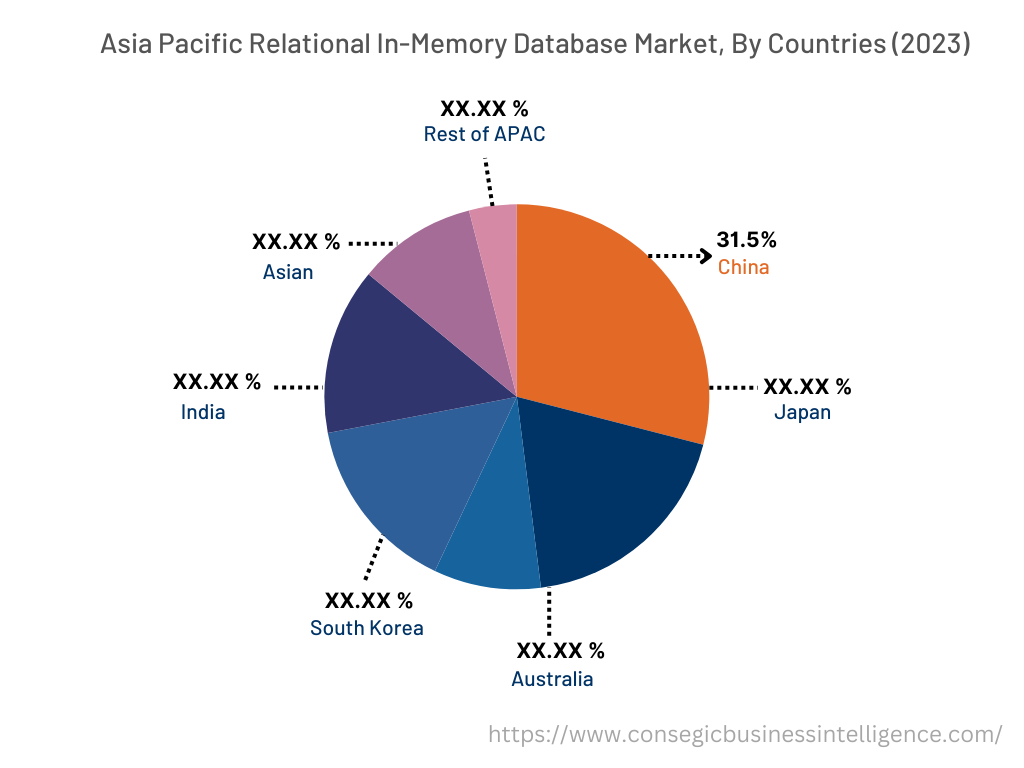
Top Key Players & Market Share Insights :
The global relational in-memory database market is highly competitive with major players providing this in-memory database to the national and international markets. Key players are adopting several strategies in research and development (R&D), product innovation, and end-user launches to hold a strong position in relational in-memory database market. Key players in the relational in-memory database industry include-
Recent Industry Developments :
- In September 2023, Microsoft announced its latest release of SQL Server 2019 which is integrated with new and updated features including in-memory database to deliver high scalability and performance across all workloads.
Key Questions Answered in the Report
What is relational in-memory database? +
Relational in-memory database refers to a purpose-built database that primarily depends on internal memory for data storage.
What specific segmentation details are covered in the relational in-memory database report, and how is the dominating segment impacting the market growth? +
For instance, by deployment segment has witnessed cloud as the dominating segment in the year 2023, owing to the increasing prevalence of significant number of relational in-memory database providers offering cloud-based deployment for database.
What specific segmentation details are covered in the Relational In-Memory Database market report, and how is the fastest segment anticipated to impact the market growth? +
For instance, by end-user segment has witnessed retail & e-commerce as the fastest-growing segment during the forecast period due to rising adoption of relational in-memory database by retail enterprises for facilitating supply chain management and driving operational efficiency.
Which region/country is anticipated to witness the highest CAGR during the forecast period, 2024-2031? +
Asia-Pacific is anticipated to register fastest CAGR growth during the forecast period due to rapid pace of industrialization and growth of multiple industries such as including BFSI, manufacturing, and others.
